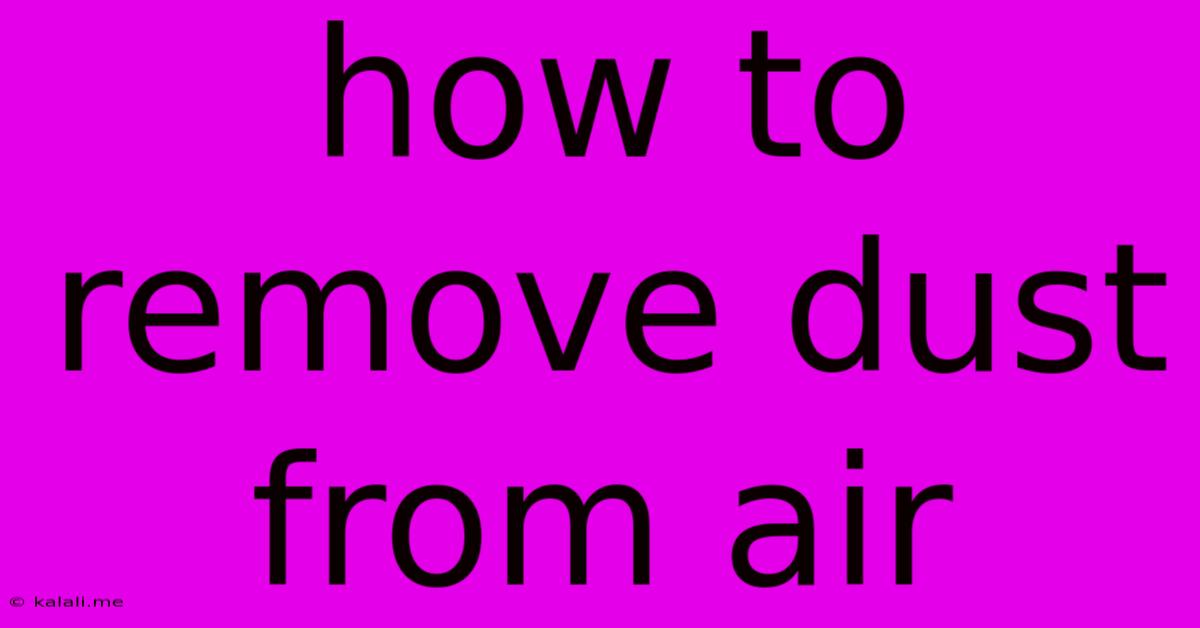How To Remove Dust From Air
Kalali
Jun 05, 2025 · 3 min read

Table of Contents
How to Remove Dust from Air: A Comprehensive Guide for Cleaner Breathing
Dust particles, invisible to the naked eye yet ubiquitous in our environment, significantly impact indoor air quality. Breathing in dusty air can trigger allergies, asthma, and other respiratory problems. This comprehensive guide explores effective methods to remove dust from the air, creating a healthier living space for you and your family. We'll cover everything from simple everyday practices to more advanced air purification techniques.
Understanding the Dust Problem: Types and Sources
Before diving into solutions, let's understand what we're dealing with. Dust isn't a single entity; it's a complex mixture of tiny particles, including:
- Pollen: A significant allergen, especially during pollen season.
- Pet dander: Microscopic skin flakes shed by pets, a common trigger for allergies.
- Mold spores: Microscopic fungal spores that can cause respiratory issues and allergies.
- Dust mites: Microscopic creatures that thrive in dust, producing allergens.
- Soil particles: Brought in from outside through open doors and windows.
- Textile fibers: From carpets, upholstery, and clothing.
- Construction debris: Particularly prevalent in older homes or during renovations.
These particles can circulate in the air for extended periods, settling on surfaces and causing a variety of problems.
Effective Methods to Remove Dust from Air
Now let's explore practical solutions to tackle dust and improve indoor air quality:
1. Regular Cleaning: This is the cornerstone of dust control. Focus on these key areas:
- Vacuuming: Use a vacuum cleaner with a HEPA filter to capture fine dust particles. Pay attention to carpets, rugs, upholstery, and curtains. Consider vacuuming at least twice a week, more often if you have pets.
- Dusting: Use microfiber cloths or dust mops, which are more effective than feather dusters at trapping dust. Dust surfaces regularly, working from top to bottom to prevent re-settling of dust.
- Washing: Regularly wash bedding, curtains, and other textiles to remove accumulated dust mites and other allergens.
- Air vents: Don't forget to clean air vents and registers regularly to prevent dust buildup and improve airflow efficiency.
2. Air Purifiers: These appliances are specifically designed to filter airborne particles.
- HEPA filters: Look for air purifiers with HEPA (High-Efficiency Particulate Air) filters. HEPA filters are highly effective at removing a wide range of airborne particles, including dust, pollen, and pet dander.
- Activated carbon filters: These filters are useful for removing odors and certain gases in addition to dust.
- Air purifier placement: Strategically place air purifiers in high-traffic areas or bedrooms for maximum impact.
3. Improve Ventilation: Proper ventilation helps reduce dust accumulation and dilutes the concentration of airborne particles.
- Open windows: Open windows for a few minutes each day to allow for air circulation, but be mindful of outdoor air quality.
- Exhaust fans: Use exhaust fans in bathrooms and kitchens to remove moisture and airborne particles.
- Air conditioning: Air conditioners can help filter out some dust and allergens, but they are not a replacement for other dust removal methods.
4. Minimize Dust Sources: Reducing the amount of dust entering your home is crucial.
- Remove clutter: Fewer items mean less surface area for dust to settle on.
- Regularly wash pets: This reduces the amount of pet dander in your home.
- Use doormats: Place doormats inside and outside entrances to trap dust and dirt.
- Air sealing: Seal cracks and gaps in your home to prevent the entry of dust and other pollutants.
5. Consider Professional Cleaning: For thorough cleaning, especially in hard-to-reach areas, consider hiring a professional cleaning service specializing in deep cleaning and allergen removal.
By implementing these strategies consistently, you can significantly reduce the amount of dust in your air, creating a healthier and more comfortable living environment. Remember, maintaining a clean home and using appropriate air purification methods are vital for minimizing exposure to airborne dust and improving overall respiratory health.
Latest Posts
Latest Posts
-
100 Amp Breaker Box Wiring Diagram
Jun 07, 2025
-
How Fast Can A Cop Car Go
Jun 07, 2025
-
Can Vulcans Mate With Humans For Pon Farr
Jun 07, 2025
-
How To Become Associate Editor Of A Journal
Jun 07, 2025
-
Can Elastic Potential Energy Be Negative
Jun 07, 2025
Related Post
Thank you for visiting our website which covers about How To Remove Dust From Air . We hope the information provided has been useful to you. Feel free to contact us if you have any questions or need further assistance. See you next time and don't miss to bookmark.